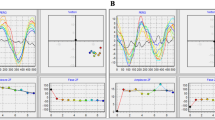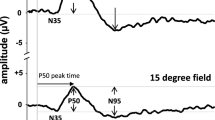Abstract
The human pattern-reversal retinal potential (PRRP) is a bioelectrical response which reflects neural activity generated in the proximal retina. Visual diseases which affect the retinal ganglion cells and the optic nerve often produce significant reductions in the amplitude of the PRRP. PRRP amplitude reductions are frequently observed in patients with primary open-angle glaucoma. This investigation was designed to determine whether patients with ocular hypertension who are at risk of developing glaucoma also exhibit PRRP amplitude reductions. The results indicate that PRRP amplitude reductions do occur in some ocular hyptertensives, but many other ocular hypertensives do not exhibit PRRP abnormalities.
Similar content being viewed by others
References
Adams AJ, Rodic R, Husted R and Stamper R (1982) Spectral sensitivity and color discrimination changes in glaucoma and glaucoma suspect patients. Invest Ophthalmol and Vis Sci 23/516
Atkin A, Wolstein M, Bodis-Wollner I, Anders M, Kels B and Podos SM (1980) Interocular comparison of contrast sensitivities in glaucoma patients and suspects. Brit J Ophthalmol 64: 858
Bobak P, Bodis-Wollner I, Harnois C, Maffei L, Mylin L, Podos S and Thornton J (1983) Pattern electroretinograms and visual evoked potentials in glaucoma and multiple sclerosis. Amer J Ophthalmol 96: 72
Dawson WW, Maida T and Rubin ML (1982) Human pattern evoked retinal responses are altered by optic nerve atrophy. Invest Ophthalmol and Vis Sci 22: 796
Dawson WW, Trick GL and Litzkow C (1979) An improved electrode for electroretinography. Invest Ophthalmol and Vis Sci 18: 988
Hart WM Jr, Yablonski M, Kass M and Becker B (1979) Multivariate analysis of the risk of glaucomatous visual field loss. Arch Ophthalmol 97: 1455
Hollander H, Bisti S, Maffei L and Hebel R (1984) Electroretinographic responses and retrograde changes of retinal morphology after intracranial optic nerve section. A quantitative analysis in the cat. Exp Brain Res 55: 483
Maffei L and Fiorentini A (1981) Electroretinographic responses to alternating gratings before and after section of the optic nerve. Science 211: 953
May JG, Ralston JV, Reed JL and Vaan Dyck HJL (1982) Loss in pattern elicited electroretinograms in optic nerve dysfunction. Amer J Ophthalmol 93: 418
Quigley HA, Hohman RM, Addicks EM, Massof RW and Green WR (1983) Morphologic changes in the lamina cribrosa correlated with neural losss in open-angle glaucoma. Am J Ophthalmol 95: 673
Quigley HA and Hendrickson A (1984) Chronic experimental glaucoma in primates: Blood flow study with iodoantipyrine and pattern of selective ganglion cell loss. Invest Ophthalmol and Vis Sci (ARVO Supple) 25: 225
Regan D and Neima D (1984) Balance between pattern and flicker sensitivities in the visual fields of ophthalomological patients. Brit J Ophthalmol 68/310
Seiple W, Price MJ, Kupersmith M and Carr RE (1983) The pattern electroretinogram in optic nerve disease. Ophthalmology 90: 1127
Towle VL, Moskowitz A, Sokol S and Schwanz B (1983) The visual evoked potential in glaucoma and ocular hypertension: Effects of check size, field size and stimulation rate. Invest Ophthalmol and Vis Sci 24: 175
Trick GL. Retinal potentials in patients with primary openangle glaucoma: Physiological evidence for temporal tuning deficits. Invest Ophthalmol and Vis Sci (in press)
Tyler CW (1981) Specific deficits in flicker sensitivity in glaucoma and ocular hypertension. Invest Ophthalmol and Vis Sci 20: 204
van Lith G, Ringens P and de Heer LJ (1984) Pattern electroretinogram and glaucoma. Developments in Ophthalmolgy (Vol ]), Straub W ed. S Karger, Basel
Wanger P and Persson HE (1983) Pattern-reversal electro-retinograms in unilateral glaucoma. Invest Ophthalmol and Vis Sci 24: 749
Author information
Authors and Affiliations
Additional information
Supported in part by Research Grant EY 04464 from the National Eye Institute.
Rights and permissions
About this article
Cite this article
Trick, G.L. Pattern reversal retinal potentials in ocular hypertensives at high and low risk of developing glaucoma. Doc Ophthalmol 65, 79–85 (1987). https://doi.org/10.1007/BF00162723
Issue Date:
DOI: https://doi.org/10.1007/BF00162723




